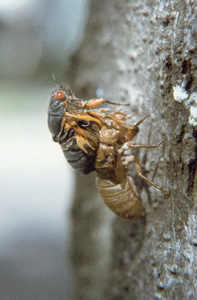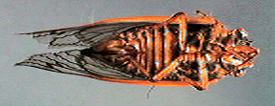
[Are periodical cicadas dangerous?] [Magicicada life cycles] [Magicicada diseases and deformities] [Magicicada abdomen color chart] [A gallery of additional Magicicada photos] [Click here to obtain reprints] [Visit Chris Simon's website to read more]
All but a few cicada species have multiple-year life cycles, most commonly 2-8 years (de Boer and Duffels 1996). In most species, adults can be found every year because the population is not developmentally synchronized; these are often called "annual" cicada species. In contrast, the cicadas in a periodical cicada population are synchronized, so that almost all of them mature into adults in the same year. The fact that periodical cicadas remain locked together in time is made even more amazing by their long life-cycles of 13 or 17 years.
Periodical cicadas are found in eastern North America and belong to the genus Magicicada. There are seven species -- four with 13-year life cycles (including one new species just described), and three with 17-year cycles. The three 17-year species are generally northern in distribution, while the 13-year species are generally southern and midwestern. Magicicada are so synchronized developmentally that they are nearly absent as adults in the 12 or 16 years between emergences. When they do emerge after their long juvenile periods, they do so in huge numbers, forming much denser aggregations than those achieved by most other cicadas. Many people know periodical cicadas by the name "17-year locusts" or "13-year locusts", but they are not true locusts, which are a type of grasshopper.
Magicicada adults have black bodies and striking red eyes and orange wing veins, with a black "W" near the tips of the forewings. Most emerge in May and June. Some of the annual cicada species are sometimes mistaken for the periodical cicadas, especially those in the genera Diceroprocta and Okanagana; these other species emerge somewhat later in the year but may overlap with Magicicada. The Okanagana species are the most potentially confusing because some have similar black-and-orange coloration. Other Common North American non-periodical cicadas include the large, greenish "dog-day" cicadas (genus Tibicen) found throughout the U.S. in the summer. Non-periodical cicadas are often called "annual cicadas" (even though they have multiple-year life cycles) because in a given location adults can be found every year. The best way to identify cicada species is by the sounds that they make, because cicada songs are nearly always species-specific. Recordings of periodical cicadas can be found below.
Female periodical cicadas (see picture below) have a pointed abdomen with an ovipositor for laying eggs. The ovipositor is sheathed and not clearly visible in these photographs.

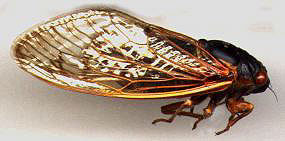
Males (below) have a blunter abdomen and white, ribbed tymbals located on the sides of the first abdominal segment, just behind the point of attachment of the hindwings. The lowest photo shows a male M. septendecim with wings removed to show the tymbal.



Cicadas do not possess special defensive mechanisms -- they do not sting or bite. The ovipositor is used only for laying eggs and the mouthparts are used only for feeding on twigs; thus, periodical cicadas can hurt you only if they mistake you for a tree branch! When approached, a cicada will simply fly away. If handled, both males and females struggle to fly, and males make a loud defensive buzzing sound that may startle but is otherwise harmless. Cicadas are not poisonous or known to transmit disease.
Periodical cicadas may cause physical damage to small trees or shrubs if too many feed from the plant or lay eggs in its twigs; such damage can cause "flagging," or breaking of peripheral twigs. When these twigs die, they become brown, as in the photo below.
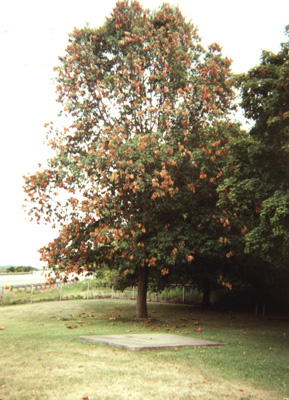
Other than the concern by owners of fruit orchards and nurseries, periodical cicadas are not regarded as pests, except maybe by those who tire of the din of their choruses.
Cicada juveniles are called "nymphs" and live underground, sucking root fluids for food. Periodical cicadas spend five juvenile stages in their underground burrows, and during their 13 or 17 years underground they grow from approximately the size of a small ant to nearly the size of an adult. The photographs below show 4-year old Brood III nymphs in underground tunnels.
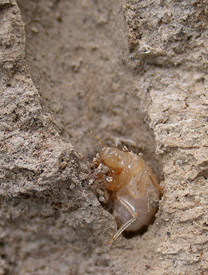 |
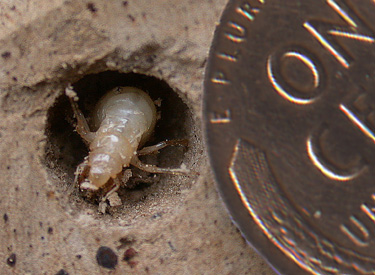 |
In the spring of their 13th or 17th year, a few weeks before emerging, the nymphs construct exit tunnels to the surface. These exits are visible as approximately 1/2 inch diameter holes, or as chimney-like mud "turrets" the nymphs sometimes construct over their holes.
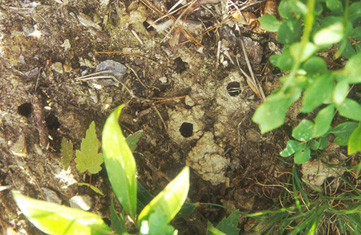
On the night of emergence, nymphs leave their burrows after sunset (usually), locate a suitable spot on nearby vegetation, and complete their final molt to adulthood. Shortly after ecdysis (molting) the new adults appear mostly white, but they darken quickly as the exoskeleton hardens. The cues that determine the particular night on which the nymphs emerge and molt are not well understood, but soil temperature probably plays an important role (Heath 1968). Sometimes a large proportion of the population emerges in one night. Newly-emerged cicadas spend roughly four to six days as "teneral" adults before they harden completely (possibly longer in cool weather); they do not begin adult behavior until this period of maturation is complete.

It appears that the particular night of emergence may be determined by the soil temperature; nymphs emerge when the soil temperature inside the exit tunnel (and therefore the body temperature of the nymph) exceeds approximately 64 degrees F (Heath 1968). Because emergence is temperature-dependent, periodical cicadas tend to emerge earlier in southern and lower-elevation locations. For example,cicadas in South Carolina often begin to emerge in late April, while those in southern Michigan do not appear until June. The best way to predict the time of emergence for your area is to check records from the prior emergence in that location, by asking longtime residents or by searching local newspaper archives. The date of emergence does not vary much between generations, although unusual springtime weather conditions may accelerate or delay the emergence by a week or so.
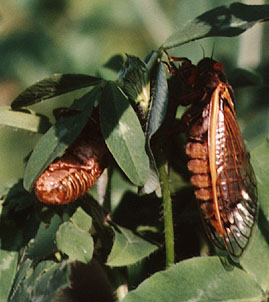
After their short teneral period, males begin producing species-specific calling songs and form aggregations (choruses) that are sexually attractive to females. Males in these choruses alternate bouts of singing with short flights until they locate receptive females. Contrary to popular belief, adults do feed by sucking plant fluids; adult cicadas will die if not provided with living woody vegetation on which to feed (see picture below of Magicicada septendecula feeding. Adult Magicicada feed from a wide variety of deciduous plants and shrubs, but usually not from grasses. The piercing-and-sucking mouthparts are visible just behind the forelegs).
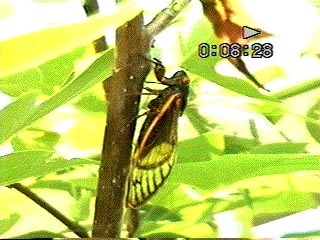
Mated females excavate a series of Y-shaped eggnests in living twigs and lay up to twenty eggs in each nest (Marlatt 1923). A female may lay as many as 600 eggs (Marlatt 1923). Below is a photograph of a female Magicicada septendecim starting to construct an eggnest. The red arrow points to the tip of her ovipositor, which she is about to insert into the branch.

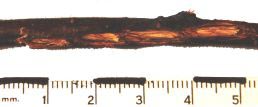 |
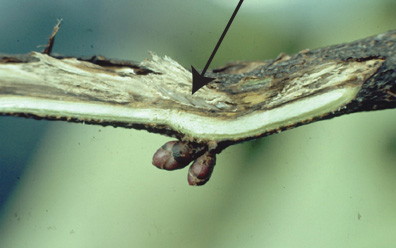 |
| A photograph of Magicicada eggnests. | When cut open, the eggnests look like this (note the small white eggs stacked in the nest) |
After six to ten weeks, in midsummer, the eggs hatch and the new first-instar nymphs drop from the trees, burrow underground, locate a suitable rootlet for feeding, and begin their long 13- or 17-year development.
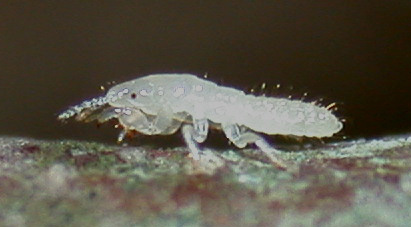
But by the time that the nymphs hatch, the adults have died. The photograph below shows piles of dead adults under an oak tree.
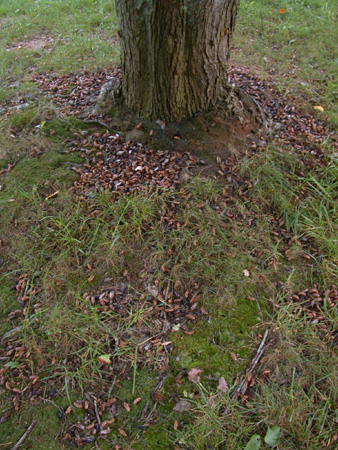
Why are there so many of them?
Periodical cicadas achieve astounding population densities, as high as 1.5 million per acre (Dybas 1969). Densities of tens to hundreds of thousands per acre are more common, but even this is far beyond the natural abundance of most other cicada species. Apparently because of their long life cycles and synchronous emergences, periodical cicadas escape natural population control by predators, even though everything from birds to spiders to snakes to dogs eat them opportunistically when they do appear. Magicicada population densities are so high that predators apparently eat their fill without significantly reducing the population (a phenomenon called "predator satiation"), and the predator populations cannot build up in response because the cicadas are available as food above ground only once every 13 or 17 years.
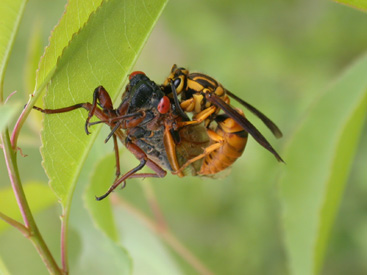
Periodical cicadas do have a specialized fungal parasite (see the Magicicada diseases and deformities section), but its effects on Magicicada population density are not well understood. Individual periodical cicadas are slower, less flighty, and easier to capture than other cicadas, probably because the safety afforded by their great numbers means that the risks of predation for an individual are low. Explaining the evolution of such an unusual life strategy is one of the most difficult problems for periodical cicada biologists.
Magicicada do not have any specialized predators, but periodical cicadas are subject to infection by the specialized fungal parasite Massospora cicadina Peck. During an emergence of periodical cicadas, both sexual and asexual forms of the fungus are present. Cicadas infected early in the emergence develop asexual spores, which become evident as the rear of the infected individual's abdomen breaks off, exposing a white, chalky mass of spores. This infection sterilizes the cicada but does not kill it immediately. These spores spread among the population, infecting other cicadas who will develop a secondary infection and whose abdomens will later break open, releasing sexual resting spores to infect the next generation of cicadas.
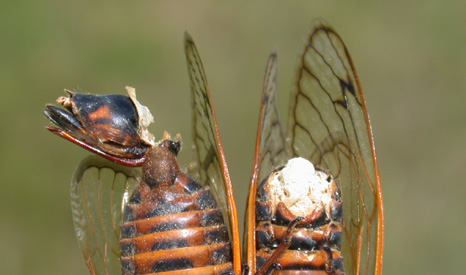
Cicadas sometimes fail to properly inflate their wings after molting; such individuals can be found in low vegatation in any emergence. There may be a tendency for this to occur more often in certain situations. The cicadas in the picture below came from a 1990 emergence in a suburban front yard near Chicago. Many of the cicadas in this area had deformed wings. Possible explanations include crowding (during molting) and use of lawn chemicals.
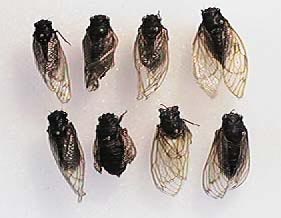
Molting can go wrong in other ways too. The cicada in the picture below failed to emerge completely from its nymphal skin. It died partially emerged.
